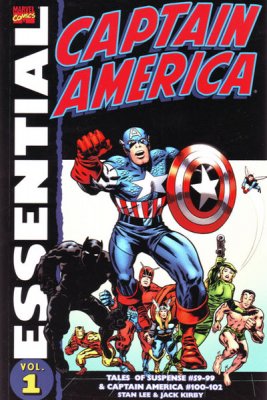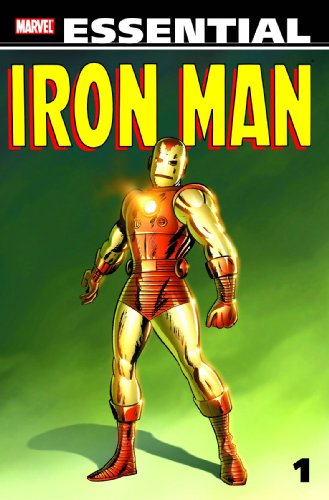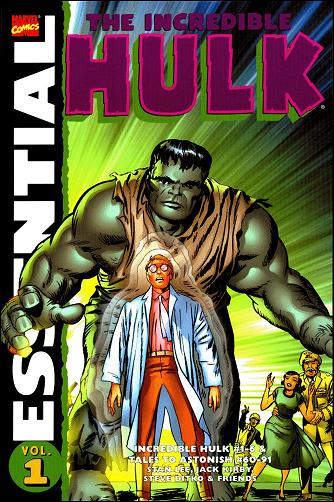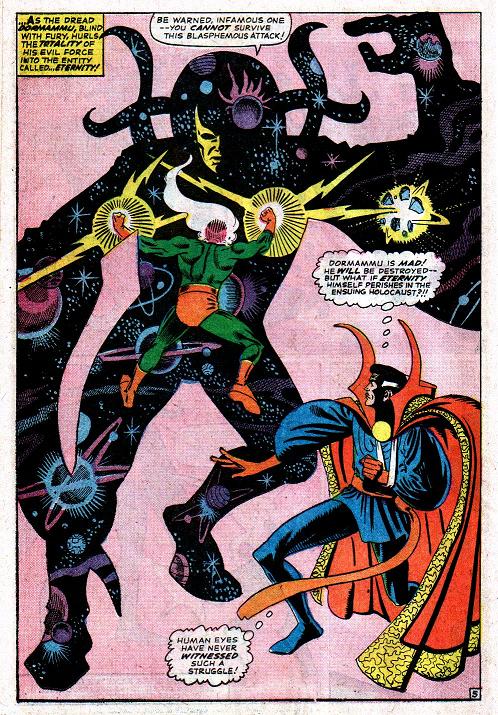
Essential Captain America Vol. 1
Stan Lee, Jack Kirby, Gil Kane and friends
Reprints: Tales of Suspense #59-99, Captain America #100-102 (November 1964 – June 1968)
Get this for: Classic Captain America — five stars
Believe it or not, Captain America is my favourite Marvel superhero, largely due to Mark Gruenwald’s long run. What I like about Captain America is how leftist a patriot he is, a Roosevelt democrat and man of the people, punching out Hitler a year before America entered the war, always representing more the ideals of America than its government, in as far as a four colour hero can represent anything when he spents most of his time fighting leftover nazis, grotesque monstrosities wanting to rule the world and other sci-fi menaces…. Captain America is one of those characters who, like Spider-Man or the Thing always make a story better, almost as if writers try extra hard when they are working with them.
Essential Captain America Vol. 1 reprints Captain America’s complete run in Tales of Suspense, plus the first three issues of his own title. None of this I have read before and I therefore had no idea what was in store. Silver Age Marvel comics can be a bit hit and miss, especially the split titles like Tales of Suspense so I wasn’t expecting too much, but this was excellent. It’s clear Stan Lee has an affinity for Cap, as does Jack Kirby, who provides the majority of the art here, with only short spells by John Romita, Jack Sparling and Gil Kane interrupting his run. Inkers on the other hand change much more, from Chic Stone to Frank Giacoia to Dick Ayers to George Tuska to Joe Sinnott to Syd Shores, each making their own interpretation of Kirby’s pencils.
Artwise, what makes this volume extraordinary is the evolution in Kirby’s art. At the start of the volume he has already moved on from the clean, slightly slick understated look it had in e.g. early Fantastic Four comics, with more exagerration in movement and typical Kirby poses. By the end it’s full on Kirby, weird ultracomplex machinery, impossible anatomy, hunched poses, odd viewpoints, Kirby Krackle and all. Inbetween you can see one style mutating into the other. At each point along the way the same boundless energy slams from the page. Captain America is an action orientated strip even more so than the usual silver Age Marvel title and Kirby delights in showing Cap dodging bullets, slamming into villains and sprinting across the page to defuse a bomb in time.
The first issue is a case in point, in which Lee and Kirby introduce Cap to a new audience. Cap is minding his own business at Avengers Mansion, when a gang of toughs decide that this is the one night thye can rob the place with impunity, Cap being just a “glorified acrobat”. What follows is a quick demonstration in how tough, fast and strong he is. It’s great stuff.
Storywise Captain America took some time to find its feet, the first couple of stories being rather pedestrian, before Lee puts Cap back into World War II for ten issues, then moving back to the present for the first of several Red Skull storylines, this one featuring the menace of the Sleepers, rather silly looking giant robot menaces scheduled to wake up on Der Tag, tweny years after the end of WWII. Which rubbed my face in the strange fact that more time has now passed since these stories were first published than had passed between WWII and them. Captain America as a revived World War II hero was a much different idea when the people creating his stories had lived through it themselves than it is now. Back then the idea that Cap could regularly run into people who had remembered him from seeing him in action in France or Germany back during “the Big One” was quite natural, while by now Marvel’s floating timeline has progressed so far that you could’ve had the same effect by making him a veteran of the First Gulf War!
One of the things I feared starting this volume was that every other story in here would feature either Baron Zemo or Red Skull as the villain, which fortunately is not the case. Zemo only appears twice, while the Red Skull is used more, but each time he appears is special. Other villains include Batroc Ze Leaper, the Tumbler, the Adaptoid and Super-Adaptoid as well as the menace of Them, not to mention A.I.M. and MODOK. Cap’s allies include Nick Fury (and quite a few shared storylines with his own title in Strange Tales), the mysterious and lovely SHIELD Agent 13, Rick Jones and the Black Panther.
Great fast paced action, clever plotting and even some subtle (and not so subtle) characterisation — all that and Kirby at his peak, what more do you want?





